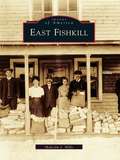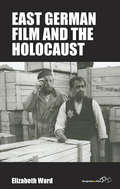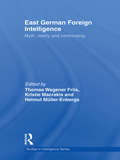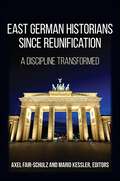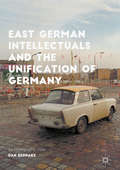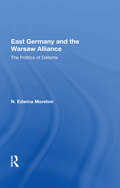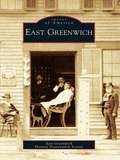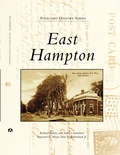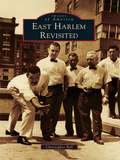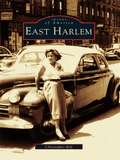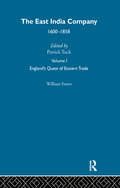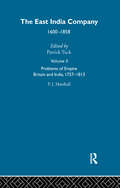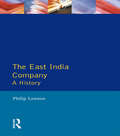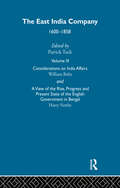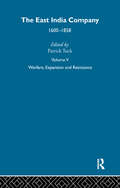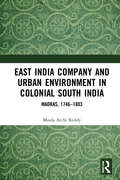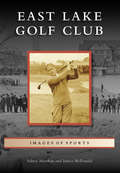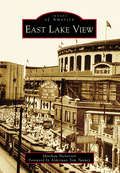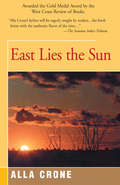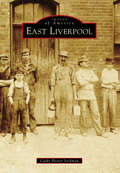- Table View
- List View
East Fishkill (Images of America)
by Malcolm J. MillsIn Revolutionary days, East Fishkill was on the route of an important highway from Boston to the Hudson River, traveled by Gen. George Washington, Gen. John Burgoyne, and John Jay. The town separated from Fishkill in 1849 and received its own charter. East Fishkill remained a mainlyagricultural community until 1960, when IBM opened achip-manufacturing plant in town. Then it changed dramatically: the farmland disappeared under housing and commercial development. East Fishkill offers a fascinating glimpse of life in the town while it was still rural.
East German Film and the Holocaust (Film Europa #22)
by Elizabeth WardEast Germany’s ruling party never officially acknowledged responsibility for the crimes committed in Germany’s name during the Third Reich. Instead, it cast communists as both victims of and victors over National Socialist oppression while marginalizing discussions of Jewish suffering. Yet for the 1977 Academy Awards, the Ministry of Culture submitted Jakob der Lügner – a film focused exclusively on Jewish victimhood that would become the only East German film to ever be officially nominated. By combining close analyses of key films with extensive archival research, this book explores how GDR filmmakers depicted Jews and the Holocaust in a country where memories of Nazi persecution were highly prescribed, tightly controlled and invariably political.
East German Film and the Holocaust (Film Europa #22)
by Elizabeth WardEast Germany’s ruling party never officially acknowledged responsibility for the crimes committed in Germany’s name during the Third Reich. Instead, it cast communists as both victims of and victors over National Socialist oppression while marginalizing discussions of Jewish suffering. Yet for the 1977 Academy Awards, the Ministry of Culture submitted Jakob der Lügner – a film focused exclusively on Jewish victimhood that would become the only East German film to ever be officially nominated. By combining close analyses of key films with extensive archival research, this book explores how GDR filmmakers depicted Jews and the Holocaust in a country where memories of Nazi persecution were highly prescribed, tightly controlled and invariably political.
East German Foreign Intelligence: Myth, Reality and Controversy (Studies in Intelligence)
by Thomas Wegener FriisThis edited book examines the East German foreign intelligence service (Hauptverwaltung Aufklärung, or HVA) as a historical problem, covering politics, scientific-technical and military intelligence and counterintelligence. The contributors broaden the conventional view of East German foreign intelligence as driven by the inter-German conflict to include its targeting of the United States, northern European and Scandinavian countries, highlighting areas that have previously received scant attention, like scientific-technical and military intelligence. The CIA’s underestimation of the HVA was a major intelligence failure. As a result, East German intelligence served as a stealth weapon against the US, West German and NATO targets, acquiring the lion’s share of critical Warsaw Pact intelligence gathered during the Cold War. This book explores how though all of the CIA’s East German sources were double agents controlled by the Ministry of State Security, the CIA was still able to declare victory in the Cold War. Themes and topics that run through the volume include the espionage wars; the HVA's relationship with the Russian KGB; successes and failures of the BND (West German Federal Intelligence Service) in East Germany; the CIA and the HVA; the HVA in countries outside of West Germany; disinformation and the role and importance of intelligence gathering in East Germany. This book will be of much interest to students of East Germany, Intelligence Studies, Cold War History and German politics in general. Kristie Macrakis is Professor at the Georgia Institute of Technology, Atlanta. Thomas Wegener Friis is an Assistant Professor at the University of Southern Denmark’s Centre for Cold War Studies. Helmut Müller-Enbergs is currently a Visiting Professor at the University of Southern Denmark and holds a tenured senior staff position at the German Federal Commission for the STASI Archives in Berlin.
East German Historians since Reunification: A Discipline Transformed
by Axel Fair-Schulz; Mario KesslerWith German reunification and the demise of the German Democratic Republic in 1990, East German historians and their traditions of historiography were removed from mainstream discourse in Germany and relegated to the periphery. By the mid-1990s, few GDR-trained historians remained in academia. These developments led to a greater degree of intellectual pluralism, yet marginalized many accomplished scholars. East German Historians since Reunification assesses what was gained and lost in the process of dissolving and remaking GDR institutions of historical scholarship. The collection combines primary and secondary sources: younger scholars offer analyses of East German historiography, while senior scholars who lived through the dismantling process provide firsthand accounts. Contributors address broad trends in scholarship as well as particular subfields and institutions. What unites them is a willingness to think critically about the achievements and shortcomings of GDR historiography, and its fate after German reunification.
East German Intellectuals and the Unification of Germany
by Dan BednarzThis book discusses the reunification of Germany, and the negative impacts that this had on East German intellectuals. The book is an ethnographic account of how the intellectuals of East Germany reacted to the demise of their nation, their "dream" of a socialist world, and unification with capitalist West Germany. Part I covers unification, 1990-91; Part II presents a quarter century later follow-up with one-fourth of those interviewed in 1990-91; and Part III examines the case from three social science perspectives.
East Germany And The Warsaw Alliance: The Politics Of Detente
by Daniel MoretonThis volume examines the role and influence of the GDR in Eastern Europe, focusing on the changing nature of the German problem and the impact of East Germany on the pattern of relations within the Warsaw alliance from 1967 to the present. After tracing the origins and development of the various issues that make up the contemporary German problem,
East Greenwich
by East Greenwich Historic Preservation SocietyEast Greenwich, the eighth-oldest town in the state, was named for the original Greenwich in Kent County, England. The eastern edge rests on the Narragansett Bay, and the western land gracefully rises up four picturesque hills. Originally owned by the Narragansett Indians, the territory was acquired by King Charles II in 1644. It was incorporated as a town on October 13, 1677, when the Rhode Island General Assembly granted land to men who served during King Philip's War. The town's sheltered cove nurtured a thriving seaport community, and successful boatbuilding, rope making, and fishing industries emerged. Inhabitants of the western part of the village focused on farming, and a prosperous textile industry lasted until the end of World War II.
East Hampton (Postcard History)
by Richard Barons Mayor Paul Rickenbach Jr. Isabel CarmichaelEast Hampton began as a fishing and farming community in the 1600s, but by the late 18th century, the area had grown to be a popular summer destination. Within a year of its construction in 1796, the Montauk Lighthouse was already attracting tourists. By the mid-19th century, steamships and railroads were taking visitors to see the magnificent beaches and stay in the boardinghouses. The smaller East Hampton communities, such as Montauk, Amagansett, and Wainscott, also became favored locations for people escaping the heat of the cities, and they remain highly sought-after destinations today.
East Harlem Revisited
by Christopher BellEast Harlem Revisited presents a fresh look at this historic neighborhood through rare photographic images. Photographs taken from tenement rooftops, at family gatherings, and of sports and events celebrate a bygone era and the neighborhood's diversity. A neighborhood of many ethnicities and languages, at one time a section of East Harlem made up the largest Little Italy in the country. The landmarks that have been preserved throughout the years detail the importance and impact of architectural development on East Harlem's history. Photographs of the neighborhood's tenements and public housing depict East Harlem's changing landscape, while images of famous residents celebrate the many talented individuals who have called East Harlem home.
East Harlem: Oral Histories Of Community And Diversity (Images of America)
by Christopher BellOvershadowed by the fame of Harlem and the wealth of the Upper East Side, East Harlem is rarely noted as a historical enclave. However, from the early 1800s through today, East Harlem has welcomed wave after wave of immigrants struggling for a place in the nation's most famous city. African Americans, Irish, Germans, European Jews, Italians, Scandinavians, Puerto Ricans, and Latinos are among the ethnic groups who have shaped this neighborhood, bringing with them their religious, social, and culinary traditions. East Harlem is the first volume to tell this neighborhood's history through images. Photographs of the iron, stone, and rubber factories, the tenements, the 100th Street community, famous politicians such as Fiorella LaGuardia, the Second and Third Avenue elevated subways, St. Cecilia's, and many other subjects capture East Harlem's past in one memorable collection.
East India
by Colin FalconerIn any other circumstance but shipwreck, rape and murder, a man like Michiel van Texel would never have met a fine lady such as Cornelia Noorstrandt. He was just a soldier, a sergeant in the Dutch East India company’s army, on his way from Amsterdam to the Indies to fight the Mataram. Such a woman was far above the likes of him. But both their destinies intertwine far away from Holland, on some god-forsaken islands near the Great Southland. When their great ship, the Utrecht, founders far from home, surviving the Houtman Rocks is the least of their worries. As they battle to survive and the bravest and the best reveal themselves for what they are, Cornelia’s only hope is a mercenary in a torn coat who shows her that a man is more than just manners and money. He makes her one promise: ‘Even if God forsakes you, I will find you.’ But can he keep it? Described by one critic as ‘Jack and Rose in the seventeenth century’, East India will keep you wondering until the final page.
East India Company V1
by William FosterFirst published in 2004. The purpose of this reference work is to offer a range of materials covering the history of the East India Company during the two and a half centuries of its existence.Volume I, Sir William Foster's England's Quest of Eastern Trade, examines the English investigation of trade routes to the East in the sixteenth century, and contains a scholarly and vivid account, not only of the foundation of the East India Company in 1599-1600, but also of its subsequent growth in the seventeenth century.
East India Company V2: Britain And India, 1757-1813 (Routledge Library Editions: The British Empire Ser. #4)
by P. J. MarshallFirst published in 2004. The purpose of this reference work is to offer a range of materials covering the history of the East India Company during the two and a half centuries of its existence.Volume II, Peter Marshall's Problems of Empire. Britain and India, 1757-1813 surveys, partly through the medium of original documents, the Company's complex transformation from a trading concern to an imperial power.
East India Company V4
by Patrick TuckFirst published in 2004. The purpose of this reference work is to offer a range of materials covering the history of the East India Company during the two and a half centuries of its existence. Volume IV, entitled Trade, Finance and Power, considers the Company's exercise of power in relation to a number of economic issues, and covers not only its official trade, but the entrepreneurial activities of private individuals operating under Company licence.
East India Company V6
by C. H. PhilipsFirst published in 2004. The purpose of this reference work is to offer a range of materials covering the history of the East India Company during the two and a half centuries of its existence. Volume 6 includes C. H. Philips' The East India Company, 1784-1834, a classic study first published in 1940, examines the final struggle between the directors of the East India Company and home governments in Britain for ascendancy over management of the company as a state in India.
East India Company , The: A History (Studies In Modern History)
by Philip LawsonThis is the first short history of the East India Company from its founding in 1600 to its demise in 1857, designed for students and academics. The Company was central to the growth of the British Empire in India, to the development of overseas trade, and to the rise of shareholder capitalism, so this survey will be essential reading for imperial and economic historians and historians of Asia alike. It stresses the neglected early years of the Company, and its intimate relationship with (and impact upon) the domestic British scene.
East India Company V3
by William BoltsFirst published in 2004. The purpose of this reference work is to offer a range of materials covering the history of the East India Company during the two and a half centuries of its existence. Volume III provides primary materials on the vivid controversy that engulfed the Company at one of the most crucial moments in this transition, leading to the British government's first intervention in 1772-3 to reconstruct the Company's management both at home and in India. The controversy is examined through two publications, William Bolts' Considerations on India Affairs (1772) and Harry Verelst's A View of the Rise, Progress and Present State of the English Government in Bengal (1772).
East India Company V5
by Patrick TuckFirst published in 2004. The purpose of this reference work is to offer a range of materials covering the history of the East India Company during the two and a half centuries of its existence. Volume V, entitled Warfare, Expansion and Resistance, raises a number of questions connected with the Company's growing military role, and examines some of the implications of Indian resistance to the growth of its power.
East India Company and Trade in South India: Madras, 1746–1803
by Moola Atchi ReddyThis book presents the economic history of the English East India Company’s trade as it functioned from Madras (Chennai) during the second half of the 18th century. It traces the role of trade and commerce as followed by the European EICs to achieve their economic ends, territorial expansion, and control of productive resources. The author portrays the nature, contents, volume, and the changing trends of trade and commerce over a decisive period of Indian economic history. The volume discusses the chief constituents of trade in general, exports, investments, imports, and private trade and traders of Madras from 1746 to 1803. Rich in archival resources, this is an essential resource for administrators, students, scholars, and researchers of colonial history, modern Indian economic history, besides British trade history.
East India Company and Urban Environment in Colonial South India: Madras, 1746–1803
by Moola Atchi ReddyThis book makes a pioneering attempt to analyse the linkages between the rule of East India Company and urban environment in colonial India over more than a half-century - from 1746 to 1803 - through a study of the city of Madras (present Chennai). The book traces urban development in colonial South India from a broad economic history point of view and with a focus on its environmental dimension, covering the period from the First Carnatic War until the 18th century by which time the English East India Company had consolidated its power. It discusses themes such as urban development; infrastructural development; housing and buildings, city and suburbs; and development of land and roads in the colonial period. Using extensive archival resources, it offers new insights on the various aspects of the shifting urban physical environment and captures the development of Madras city limits; road infrastructure, building of paved streets, whitewashed walls and compounded houses; establishment of garden houses; use of land resources; development of masonry bridges by merchants; housing problems; and the building of Fort House, Garden House, Admiralty House, Pantheon House, Custom House, etc. in Madras, to describe the impact of colonialism on urban environment. An important contribution to the history of urban economics and environment, this book with its lucid style and rich illustrations will be an essential read for scholars and researchers of colonial history, modern Indian history, environmental history, urban environment, urban history, political economy, urban economic history, Indian history, and South Asian studies.
East Lake Golf Club (Images of Sports)
by Janice Mcdonald Sidney MatthewEast Lake Golf Club was heralded as "one of the finest in the United States" when its first holes were completed in 1907. Bobby Jones called East Lake his home course, as did Alexa Stirling, Watts Gunn, and Charlie Yates. It flourished in the early 1900s as the Atlanta Athletic Club's country club. However, as Atlanta's population shifted to the northern suburbs, East Lake suffered, and in the mid-1960s the AAC sold the property and moved to Johns Creek. In the 1990s, developer Tom Cousins stepped in to restore East Lake. Today, the historical East Lake Golf Club is again considered among the finest courses in the United States and is host to tournament play. The motto adopted at its rebirth rings true: "Golf with a Purpose."
East Lake View (Images of America)
by Foreword By Tunney Matthew NickersonEast Lake View is one of Chicago’s most popular neighborhoods. But what exactly is East Lake View? It is Wrigleyville, Boystown, and Belmont Harbor. It is New Town, if you talk to a longtimer. Change has swept East Lake View many times, often leaving a new name behind. One thing has stayed the same—the neighborhood’s popularity. East Lake View drew tourists as far back as 1854, when Lake View House opened as a rural resort. This book unfolds the history of East Lake View, from the 19th century to the 21st century. Readers will learn about the neighborhood’s time as a Swedish enclave and then as a haven for Japanese Americans, including Tokyo Rose. The book charts the wild 1970s on Broadway, the gay 1980s on Halsted, and the beer-soaked 1990s in Wrigleyville. This visual history of East Lake View mines Chicago archives and old-timers’ scrapbooks to reveal the neighborhood in hundreds of never before published photographs.
East Lies the Sun
by Alla CroneAn epic novel of a woman caught in the turmoil and suffering of the Russian Revolution. With indomitable courage, she would survive the savage ordeal of the Siberian Ice March to find love and make a new life in a world utterly changed. East Lies the Sun was awarded the Gold Medal Award by the West Coast Review of Books.
East Liverpool
by Cathy Hester SeckmanOnce known as the "Pottery Capital of the World," East Liverpool boasted some 300 potteries in its heyday, along with many ancillary industries. When British immigrant Thomas Bennett found promising clay deposits along the riverfront, he opened the city's first one-kiln pottery in 1839. From that humble beginning, the industry burgeoned, eventually spreading up the hills and across the river. Besides sturdy kitchenware, hotel china, toilet ware, and ceramic doorknobs and insulators, the potteries produced such elegant designs as Lotus Ware, Lu-Ray, and Fiesta Ware. The men, women, and children who worked in the potteries also built a town with a busy and complex social life. Churches, schools, cultural and service organizations, theaters, and restaurants filled the downtown area. East Liverpool struggled after the collapse of the pottery industry in the second half of the 20th century but has persevered into the 21st century with hope for the future.
